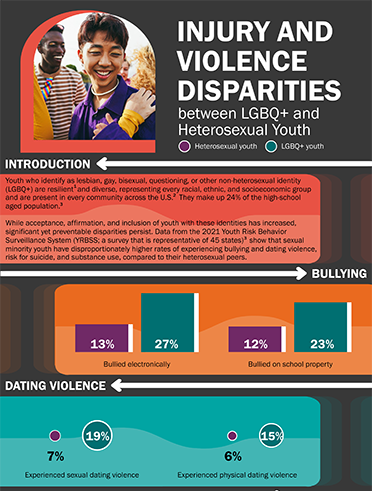
Youth who identify as lesbian, gay, bisexual, questioning, or other non-heterosexual identity (LGBQ+) are resilient1 and diverse, representing every racial, ethnic, and socioeconomic group and are present in every community across the U.S.2 They make up 24% of the high-school aged population.3 While acceptance, affirmation, and inclusion of youth with these identities has increased, significant yet preventable disparities persist.4 Data from the 2021 Youth Risk Behavior Surveillance System (YRBSS; a survey that is representative of 45 states)3 show that LGBQ+ youth have disproportionately higher rates of experiencing injury and violence, compared to their heterosexual peers.
In Children's Safety Network's new infographic, learn more about injury and violence disparities between LGBQ+ and heterosexual youth, risk factors that help us understand these disparities, and protective factors that can prevent these disparities.
Download a PDF of the infographic for printing
_____
1Lira, A. N., & Morais, N. A. (2018). Resilience in lesbian, gay, and bisexual (LGB) populations: An integrative literature review. Sexuality Research and Social Policy: A Journal of the NSRC, 15(3), 272–282. https://doi.org/10.1007/s13178-017-0285-x
2Centers for Disease Control and Prevention. (2019). Health considerations for LGBTQ youth. https://www.cdc.gov/healthyyouth/disparities/health-considerations-lgbtq-youth.htm
3Centers for Disease Control and Prevention. 2021 Youth Risk Behavior Survey Data. Available at: http://www.cdc.gov/yrbs. Accessed on January 23, 2024.
4Russell, S. T. & Fish, J. N. (2019). Sexual minority youth, social change, and health: A developmental collision. Research in Human Development, 16(1), 5-20. https://doi.org/10.1080/15427609.2018.1537772